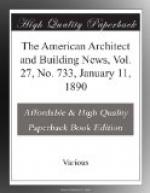It will naturally be further asked: “Is this all that has been done to demonstrate the efficiency and availability of desiccation for the dead?” To this the answer would be sufficient that the evidence that has been adduced is ample, and that, at once, in perfect confidence as to the result, mausoleums might be erected, with provision for the withdrawal of the moisture from the atmosphere, and for the passage of the desiccated air through the sepulchres in which the dead should rest. So little is involved, and so much has been accomplished without the application of any human skill, that it seems inevitable that, as soon as the resources of modern architecture and sanitary science are drawn upon, the desired result will be at once attained. But, to make assurance doubly sure, several carefully-conducted experiments have been made, under the supervision of the directors of the New Mausoleum movement, that prove that the conditions of desiccation can be controlled and that decomposition can be prevented, that where it has begun it can be stayed, and that prolonged preservation, with a fair approximation to the appearance in life, can be made sure for the recognition of absent friends, for transportation or the furtherance of the ends of justice.
When, now, it is added that desiccation has been ascertained to be an efficient agent in the destruction of disease germs, as proved by the experiments of Dr. Sternberg, of the Hoagland Laboratory, and by the investigations of other experts, enough seems to have been said to establish the truth of the assertion that entombment can be made sanitary, and that, therefore, entombment offers the satisfactory solution of the problem how to dispose of the dead so as to do no violence to a reverent and tender sentiment, and at the same time not to imperil the public health.
The proposition, then, soon to be submitted for public approval is this: to erect in the suburbs of our large towns and cities, perhaps even in their most thickly-populated parts, extensive and handsome edifices that will provide sanitary Sepulchres for the dead. To be comparatively inexpensive, they will have to be comparatively plain, and it seems not too much to hope that our cities will soon adopt this mode of disposing of the dead that depend upon the public care for burial, and that the horrors of a “Potter’s Field,” of which it cannot be divested, even in a fair and sea-girt isle, may be forevermore unknown of men....
Within there would be, as the unit of construction, each sepulchre so constructed that anhydrous air could enter, or could be made to enter and withdraw, laden with moisture and morbific matter, which it would convey to a separate structure, where a furnace would complete the sanitary work that the anhydrous air had begun, and return to the external atmosphere nothing that would be noxious. Each sepulchre, in itself and its surroundings, would appear to provide a place of repose, and would have electrical appliances attached




